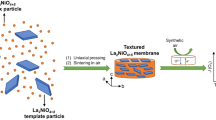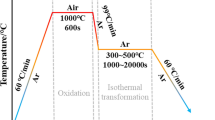Abstract
This paper describes the manufacture and properties of fine scale (Ø 260 μm) and dense (>96 % theoretical density) fibres consisting of Magnéli (TinO2n-1) phases for sensing and energy storage applications. In order to understand their operational limits, the re-oxidation of the Magnéli phases in air was examined using thermo-gravimetric analysis at temperatures up to 900 °C under a variety of heating rates. The material was characterised before and after re-oxidation via X-ray diffraction and scanning electron microscopy. The re-oxidation of the Magnéli phases was observed to begin at 650 °C, and the kinetics of the process was studied using the iso-conversional method. The calculated activation energy was consistent with Jander’s three-dimensional diffusion model, where oxidation is limited by diffusion of oxygen through a layer of the oxidised product. An activation energy of 0.71 eV was obtained from kinetic analysis of the thermogravimetry data, which is in agreement with previous work on electrical conduction of Magnéli phases using impedance spectroscopy.








Similar content being viewed by others
References
Pfaff G, Reynders P (1999) Angle-dependent optical effects deriving from submicron structures of films and pigments. Chem Rev 99:963–1981
Vannoort R (1987) Titanium: the implant material of today. J Mater Sci 22:3801–3811
Bañares MA (2011) Operando spectroscopy: the knowledge bridge to assessing structure–performance relationships in catalyst nanoparticles. Adv Mater 23:5293–5301
Chen G, Waraksa CC, Cho H, Macdonald DD, Mallouka TE (2003) EIS studies of porous oxygen electrodes with discrete particles. J Electrochem Soc 150:E423
Fox MA, Dulay MT (1993) Heterogeneous photocatalysis. Chem Rev 93(1):341–357
Fujishima A, Honda K (1972) Electrochemical photolysis of water at a semiconductor electrode. Nature 238:37–38
Oregan B, Gratzel M (1991) A low-cost, high-efficiency solar-cell based on dye-sensitized colloidal TiO2 films. Nature 353:737–740
Korotcenkov G (2007) Metal oxides for solid-state gas sensors: what determines our choice? Mat Sci Eng 139:1–23
Radecka M, Rekas M (2002) Charge and mass transport in ceramic TiO2. J Eur Ceram Soc 22:2001–2012
Nowotny MK, Bogdanoff P, Dittrich T, Fiechter S, Fujishima A, Tributsch H (2010) Observations of p-type semiconductivity in titanium dioxide at room temperature. Mater Lett 64:928–930
Nowotny J, Bak T, Nowotny MK, Sheppard LR (2007) Titanium dioxide for solar-hydrogen II. Defect chemistry. Int J Hydrog Energy 32:2630–2643
Seebauer EG, Kratzer MC (2006) Charged point defects in semiconductors. Mater Sci Eng 55:57–149
Hayfield PCS (2002) Development of a new material-monolithic Ti4O7 ebonex ceramic. R Soc Chem, Thomas Graham House
Andersson S, Magneli A (1956) Diskrete titanoxyd phasen im zusammensetzungs bereich TiO1.75-TiO1.90. Naturwissenschaften 43:495–496
Liborio L, Mallia G, Harrison N (2009) Electronic structure of the Ti4O7 Magnéli phase. Phys Rev 79:245133
Harada S, Tanaka K, Inui H (2010) Thermoelectric properties and crystallographic shear structures in titanium oxides of the Magneli phases. J Appl Phys 108:083703
Walsh FC, Wills RGA (2010) The continuing development of Magnéli phase titanium sub-oxides and Ebonex® electrodes. Electrochim Acta 55:6342–6351
Smith JR, Walsh FC, Clarke RL (1998) Reviews in applied electrochemistry. Number 50-electrodes based on Magneli phase titanium oxides: the properties and applications of Ebonex (R) materials. J Appl Electrochem 28:1021–1033
Kitada A, Hasegawa G, Kobayashi Y, Kanamori K, Nakanishi K, Kageyama H (2012) Selective preparation of macroporous monoliths of conductive titanium oxides TinO2n–1 (n = 2, 3, 4, 6). J Am Chem Soc 134:10894–10898
Li X, Zhu AL, Qu W, Wang H, Hui R, Zhang L, Zhang J (2010) Magneli phase Ti4O7 electrode for oxygen reduction reaction and its implication for zinc-air rechargeable batteries. Electrochim Acta 55:5891–5898
Gardon M, Dosta S, Guilemany JM, Kourasi M, Mellor B, Wills R (2013) Improved, high conductivity titanium sub-oxide coated electrodes obtained by atmospheric plasma spray. J Power Sources 238:430–434
Heiber J, Clemens F, Graule T, Hulsenberg D (2005) Thermoplastic extrusion to highly-loaded thin green fibres containing Pb(Zr, Ti)O3. Adv Eng Mater 7:404–408
Adamaki V, Clemens F, Ragulis P, Pennock SR, Taylor J, Bowen CR (2014) Manufacturing and characterization of Magneli phase conductive fibres. J Mater Chem A 2:8328–8333
BSI, 1993, “Advanced technical ceramics — Monolithic ceramics — General and textural properties “ Part 2: Determination of density and porosity, BSI 10-1999
Vyazovkin S, Wight CA (1997) Kinetics in solids. Annu Rev Phys Chem 48:125–149
Słoczyński J (1996) Kinetics and mechanism of reduction and reoxidation of the alkali metal promoted vanadia-titania catalysts. Appl Catal 146(2):401–423
Prudenziati M, Morten B, Travan E (2003) Reduction process of RuO2 powders and kinetics of their re-oxidation. Mater Sci Eng 98:167–176
Jander W (1927) Z Anorg Chem 1:163
Ginstling AM, Brounshteim BI (1950) J Appl Chem USSR 23:1327
Regonini D, Adamaki V, Bowen CR, Pennock SR, Taylor J, Dent ACE (2012) AC electrical properties of TiO2 and Magnéli phases, TinO2n−1. Solid State Ionics 229:38–44
Acknowledgements
Adamaki acknowledges funding by the European Union Seventh Framework Programme (FP7/2007-2013) under the Grant Agreement no. CP-TP 229099-2 as part of the ‘MesMesh’ project. Bowen acknowledges funding from the European Union’s Seventh Framework Programme (FP7/2007-2013)/ERC Grant Agreement No. 320963 on Novel Energy Materials, Engineering, Science and Integrated Systems (NEMESIS).
Author information
Authors and Affiliations
Corresponding author
Rights and permissions
About this article
Cite this article
Adamaki, V., Clemens, F., Taylor, J. et al. Re-oxidation mechanism and kinetics of fine scale Ti-Magnéli phases in fibre form using thermo-gravimetric analysis. J Mater Sci 49, 7597–7603 (2014). https://doi.org/10.1007/s10853-014-8468-9
Received:
Accepted:
Published:
Issue Date:
DOI: https://doi.org/10.1007/s10853-014-8468-9




